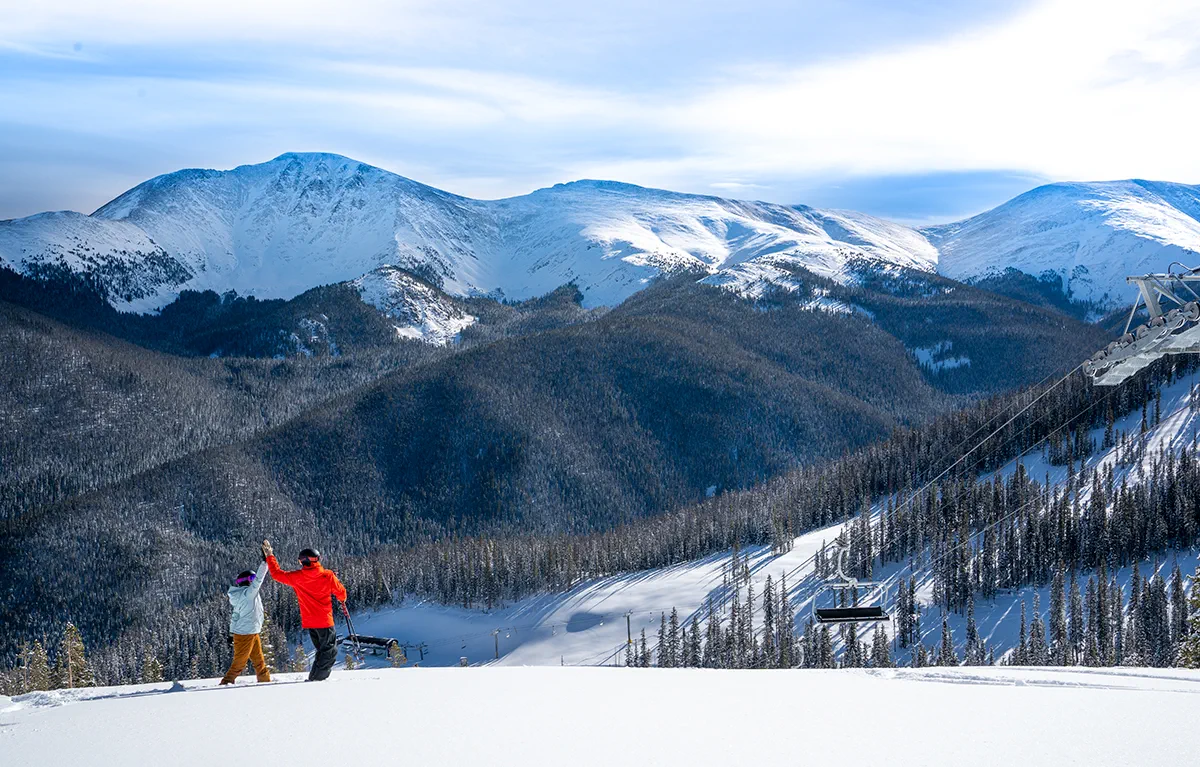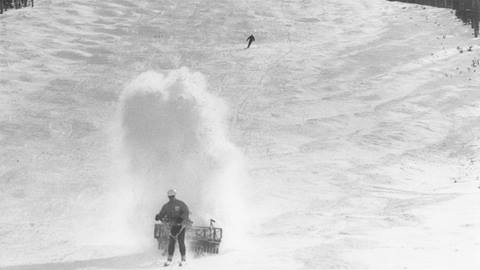Winter Park Historic Trails
HISTORIC Trails
During Winter Park's history, many individuals have made significant contributions to the development and image of the ski area. Over the years several ski trails have been identified as Historical Trails. A commemorative sign, with a brief narrative about the individual's contribution to the ski area, has been installed at a convenient location along each trail. Please take the opportunity to visit these trails while you're skiing and enjoy a bit of Winter Park history.
HUGHES
At its dedication ceremonies in 1940, Winter Park Ski Area, then a Denver mountain park, consisted of only three formal ski trails. Berrien Hughes, a Denver attorney, dedicated sportsman, and noted skiing pioneer, had introduced many of skiing's early enthusiasts to the rugged beauty and challenging terrain of the mountain around Winter Park. On May 27, 1939, Berrien Hughes died of injuries incurred in a skiing accident on Loveland Pass just days before. The first named ski trail at Winter Park commemorated the man and his contribution to the sport.
CRANMER
If credit can be given to any one person, then George E. Cranmer must be designated the father of the Winter Park Ski Area. In 1935, Cranmer became manager of Parks and Improvements for the City of Denver. An active and ardent outdoorsman, Cranmer dreamed of a mountain city park that would become a winter sports center comparable to European resorts. Cranmer possessed the energy and purpose to push his dream to fulfillment. By 1940, the first ski tow at West Portal was dedicated and Denver's Winter Park was a reality. In 1977, in recognition of his contribution to Colorado skiing, George Cranmer was inducted into the Ski Hall of Fame.
ALLAN PHIPPS
In 1950, when the City and County of Denver concluded that it could no longer operate the Winter Park Ski Area, it called upon Denver attorney Allan R. Phipps to head the newly formed Winter Park Recreation Association. Long an ardent skier and civic leader, Phipps was the first chairman of the board, setting the pattern for leadership that still exists in Winter Park today. His induction into the Colorado Ski Hall of Fame in 1988 recognized his leadership in skiing.
BRADLEY'S BASH
In 1950, Steve Bradley became the first executive director of the Winter Park Recreation Association. Under his direction, Winter Park became an industry leader in the development of new techniques to further the sport of skiing. Although he is best known for his development of the first snow grooming machine, the "Bradley Packer," he was also skilled in the design and development of ski trails. Bradley was known for the excellence of the trails he cut. Bradley's Bash is typical of his designs – straight down the fall line, with no side hill traverses. Bradley continued as executive director until 1975 and was inducted into the Colorado Ski Hall of Fame in 1979.
JACK KENDRICK
Jack Kendrick began his service to Winter Park in 1950, serving as one of the 15 original trustees appointed to operate the Winter Park Recreation Association. He was a great believer in the potential of skiing as a major tourist attraction in Colorado. Through his involvement in the Denver Chamber of Commerce and the Colorado Winter Sports Council, Jack Kendrick supported and worked for the growth of the sport from the mid-1930s. Jack was among those responsible for Colorado's first powered ski tow, a rope tow installed on Berthoud Pass in 1937.
OVER 'N UNDERWOOD
George Underwood, who headed Winter Park Resort's maintenance department, started working for the ski area in 1951. As a master welder and innovative machinist, Underwood was responsible for everything mechanical at Winter Park - from trucks and bulldozers that sculpted the resort, to the chairlifts that transported skiers. Utilizing his creativity and ingenuity, Underwood worked with Winter Park manager Steve Bradley to develop the original snow grooming device, known as the Bradley Packer, which established Winter Park as a leader in slope maintenance. At the time of his retirement in 1972, Underwood had built every existing lift and tow at the ski area. This trail commemorates the twenty-one years of dedication and service that George Underwood gave to Winter Park Resort. This recognition was donated by the family and friends of George Underwood in cooperation with the United States Forest Service and the Winter Park Recreational Association.
SORENSEN PARK
Harold "Pop" Sorensen immigrated to America in 1929 from Norway as a competitive skier and went on to teach skiing to military troops in the US, the UK, and Italy. In 1958, Pop Sorensen founded the Winter Park Ski Jump School at Winter Park Resort. The program was free to all kids ages 4-18 and led students through a series of nine hills, progressing up to the final 60-meter slope. For his efforts, Harold received the Russell Wilder Memorial award, recognizing his Winter Park program as the year's outstanding activity "focusing the interests of America's youth on the sport of skiing." Sorensen Park is a tribute to Pop's passion for teaching and dedication to the young athletes of Winter Park.
MULLIGAN'S MILE
The history of Winter Park is filled with the names of men and women whose contributions made Winter Park a special place. One such person was Dick Mulligan. Dick became Winter Park Ski Area's caretaker in 1945, living at the base area in a bunkhouse which formerly had housed construction workers building the Moffat Tunnel. For 10 years, Dick ran "his lift," the Practice Hill T-bar, welcoming many of the young sport's earliest participants to Winter Park and skiing. A friendly outgoing Irishman from Kiowa, Colorado, Dick had a well-known love for conversation and an unexcelled gift for bold exaggeration. This trail, in reality only a half mile long, is a tribute to Dick and his gift of exaggeration.
MT. MAURY
In 1953, Maury Flanagan arrived in Winter Park "in search of better snow." Maury stayed to become one of the original members of the Winter Park Ski School and a Winter Park legend. Known for his booming voice, his peers nicknamed him "Fog Horn Flanagan." His outrageous sense of humor and unique teaching methods earned him a place of honor in local skiing lore. In 1958, Maury married Glenda Rawls who founded the Winter Park children's ski school in 1961 and served as its director until 1969. The original children's teaching hill, Mt. Glenda, was relocated to this site during the construction of West Portal Station in 1980, and renamed in honor of Maury Flannagan.
RETTA'S RUN
Considered to be one of the most challenging trails at Winter Park, Retta's occupies the location of one of the earliest lifts, the Meteor T-bar. As an invaluable volunteer during the early years of Winter Park's Handicap Program, Retta Stanley gave selflessly of herself to the program and its participants. In her own struggle with disability, Retta was stricken with cancer and lost one leg. Having no pity for any handicap, including her own, she became one of the first women three-track national champions. In April 1977, Retta lost her eight year battle with cancer.
ENGELDIVE
In 1945, a 23-year-old skiing enthusiast named George Engel visited Winter Park on a ski vacation. One year later he returned to begin one of Winter Park's longest and most successful personal stories. First employed at Winter Park as a ski patrolman, by 1948 George was operating the Winter Park Ski School which he owned until its sale to the ski area in 1982. He was instrumental in the advancement of American ski instructor's organizations, serving as president of the region's professional association for 10 years. With his wife, Joyce, he owned and operated the Winter Park Ski Shop from 1946 to 1998. The two organized many social, cultural, and fundraising events for the community. The dedication of this trail in 1964 and his induction into the Colorado Ski Hall of Fame in 1987, recognize George Engel's continuous personal commitment to skiing and this community.
BALCH
Robert Balch first came to Colorado from Massachusetts in 1934 to compete in the National Ski Championships held in Estes Park. Four years later, he was hired by George Cranmer to supervise development of Denver's Winter Park at West Portal. Bob immediately began designing ski trails and tows for the proposed Winter Park Ski Area. He was responsible for laying out the original trails: Hughes, Highway Run (later abandoned), Parkway Run and Bridge Run (now Larry Sale). Balch became Winter Park's first manager in 1940, serving until his enlistment in the army in 1942. Balch would never return to his beloved Winter Park. He was lost in the Mediterranean when his troop ship was torpedoed in 1943. These trails, cut in 1945, and his induction into the Colorado Ski Hall of Fame in 1978, commemorate Balch's involvement in the development of Winter Park.
BILL WILSON'S WAY
A Colorado native and member of the University of Denver ski team, Bill "Waxy" Wilson has skiing in his blood. Following service in the Navy during World War II, Bill pursued various interests in the ski industry before settling in Winter Park in 1954, becoming a ski school instructor and serving as assistant ski school director for George Engel. Bill became director of the ski school in 1982 when it was purchased by the Winter Park Recreation Association. As a member of the ski school, with his trademark pipe clasped tightly in his jaws, he lobbied tirelessly for the development of the beginner trail that now bears his name. Sadly, Bill passed away from cancer in October, 1984, never seeing the completed trail named in his memory.
MARY JANE® TRAIL
In the early 1930s, members of the Colorado Arlberg Club began clearing the first man-made ski trail in the western part of the United States. The Mary Jane Trail, as it is now known, was named after a local lady of pleasure. Mary Jane, according to legend, acquired the land on which the existing trail now lies, as payment from railroad workers and miners for her favors. What started as a sheep trail for summer grazing has now taken its place in the annals of skiing. While Mary Jane is described as being no lady, her namesake trail is one of the finest to be found anywhere in the country. The numerous mogul runs covering Mary Jane has earned her the slogan No Pain No Jane™.
EAGLE WIND® TERRITORY
In the 1800s the Northern Arapaho Tribe inhabited the Fraser Valley. As Winter Park developed the Eagle Wind area, resort planners recognized the heritage of the land and reached out to leaders of today’s Northern Arapaho Tribe. Tribe elders visited the resort and consulted with resort planners to name and properly honor and pay tribute to the area. The Eagle Wind Lift and area opened during the 2006/2007 winter season with visiting members of the tribe and a traditional Northern Arapaho blessing ceremony. Trail names Left Hand, Sharp Nose, and Black Coal refer to prominent Arapaho leaders from the 1800s, while Thunderbird is derived from the Arapaho symbol of “the power of day and summer.” Eagle Wind was the Arapaho name for the entire land area where Winter Park Resort sits today.
rich-text, responsive-table




